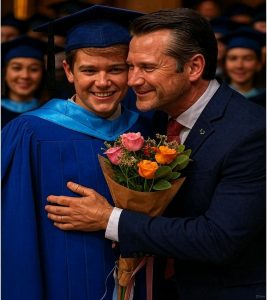A Gymnasium Gripped by Grief
The fluorescent lights of Jefferson High School’s gymnasium in suburban Minneapolis buzzed faintly on a crisp September afternoon in 2025, casting long shadows over rows of folding chairs filled with red-eyed students and faculty. Just 48 hours earlier, the community had been shattered by the sudden death of Mr. Elias Grant, the beloved history teacher whose passion for American valor had ignited countless young minds. At 52, Grant—a Gulf War veteran himself—had collapsed during a weekend hike, leaving behind a void that no lesson plan could fill. As Principal Maria Lopez took the podium, her voice trembled: “Elias wasn’t just a teacher; he was our compass.” The room, packed with 300 mourners, dissolved into quiet sobs. Then, unannounced, the doors swung open, and in walked Pete Hegseth, the newly confirmed Secretary of Defense, his presence as unexpected as it was profound. In his hands: a crisply folded American flag from a Pentagon ceremony. The air shifted—sorrow teetering on the edge of something unbreakable.

The Promise That Began in Battlefield Ink
Months before the tragedy, during a spring visit to Jefferson High as part of his pre-confirmation outreach on veteran education, Hegseth had crossed paths with Elias Grant. The two veterans bonded instantly over shared deployments—Hegseth in Iraq, Grant in Kuwait—swapping stories of sandstorms and the quiet heroism of homecomings. As Hegseth addressed a rapt assembly on “lessons from the foxhole,” Grant pulled him aside afterward, his eyes alight with a quiet fire. “These kids need to know what promise means,” Grant said, gesturing to a wall of faded service photos. “Not the flashy kind—the kind that gets you through the night.” Hegseth, moved by the teacher’s unyielding dedication to at-risk youth, made a vow on the spot: If anything ever happened to Grant, he’d ensure the school’s JROTC program received a symbol of national gratitude—a flag flown over the Capitol, presented personally. They shook on it, sealing the pact with a nod and a shared laugh about “soldier’s honor.” Little did they know, that inkless contract would become a lifeline.
The Moment of Reckoning: “I Promised, Right?”
As the memorial service dragged into its second hour, with eulogies painting Grant as the school’s moral anchor, Hegseth rose from the back row. The gymnasium fell into a stunned hush; whispers rippled like wind through dry grass. “I didn’t come here as Secretary,” he began, his baritone steady but laced with gravel from years of command posts. “I came as a brother in arms.” He recounted their chance meeting, the laughter over lukewarm coffee in the faculty lounge, and the promise exchanged amid stacks of dog-eared history texts. Then, unfolding the flag with deliberate care—its stars gleaming like distant artillery flares—Hegseth locked eyes with the front row of students, many of whom Grant had mentored through personal storms. “Elias believed in you,” he said, voice dropping to a near-whisper. “And he believed I’d show up. I promised, right?” The words hung, simple yet seismic, transforming the room’s collective ache into a wave of awe. A sophomore, clutching a tissue, gasped audibly; faculty members exchanged glances, tears carving fresh paths down weathered cheeks. Hegseth draped the flag over Grant’s empty podium, a silent sentinel, as applause mingled with muffled cries—sorrow alchemized into reverence.
Ripples of Inspiration: From Classroom to Capitol
The gesture’s impact extended far beyond those gymnasium walls. Within hours, a student’s shaky cellphone video of the moment went viral on TikTok, amassing 15 million views by evening and trending under #KeepThePromise. Comments flooded in: “This is what leadership looks like,” one veteran wrote; “Finally, a promise politicians actually keep,” quipped another. By week’s end, Jefferson High reported a 40% surge in JROTC sign-ups, with kids citing Hegseth’s authenticity as the spark. Hegseth, no stranger to scrutiny amid his contentious confirmation battles over “woke” military reforms, used the platform sparingly. In a Fox News follow-up, he deflected praise: “It wasn’t about me. Elias taught me that promises aren’t optional—they’re the glue holding us together.” Yet, insiders note the event softened his image, bridging the gap between his Fox pundit firebrand persona and the empathetic commander beneath. Schools nationwide began reaching out, inspired to weave veteran stories into curricula, while congressional aides floated bills for expanded teacher-veteran exchange programs.
Echoes of a Larger Legacy
Hegseth’s act at Jefferson High spotlights a deeper truth: In an age of fleeting commitments and partisan fractures, a single kept promise can realign horizons. Elias Grant’s legacy, amplified through Hegseth’s resolve, reminds us that inspiration often arrives not in grand speeches, but in quiet fulfillments—the “I promised, right?” that turns bystanders into believers. As fall leaves blanketed Minnesota, the school’s flag flew at half-mast no more; it waved full, a beacon for the next generation. For Hegseth, juggling Pentagon overhauls and global tensions, the moment serves as a personal anchor: a vow redeemed amid chaos. Will it inspire a ripple of similar acts across America’s heartland? Or fade as another viral footnote? One thing’s certain— in that gymnasium, sorrow didn’t just lift; it evolved, proving promises, once honored, forge futures unbreakable.
Leave a Reply